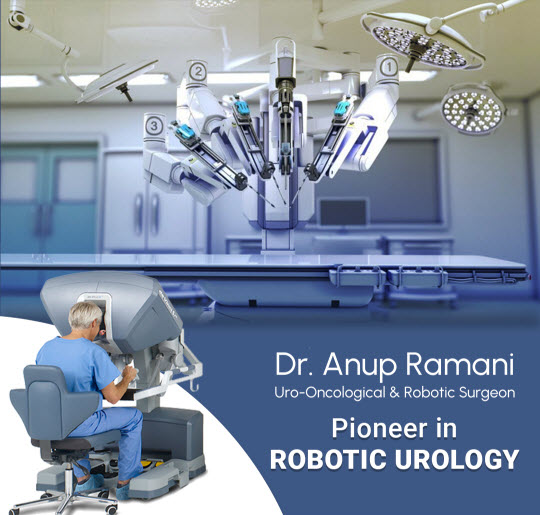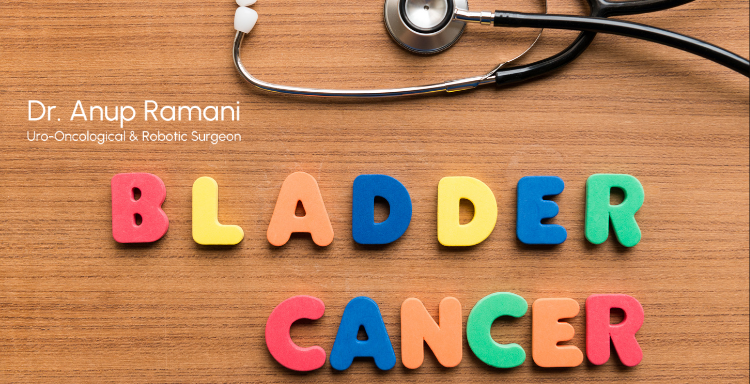Dr Anup Ramani @ Copyright 2024
By Dr. Anup Ramani
Understanding Bladder Cancer Surgery
Bladder cancer is a significant health concern affecting thousands of people worldwide. For many patients, surgery becomes an inevitable part of treatment, especially when the cancer is more advanced. While traditional open surgeries were once the norm, Minimal invasive techniques have revolutionized bladder cancer treatment. Two such techniques, Robotic Radical Cystectomy and Transurethral Resection of Bladder Tumor (TUR-BT), are gaining prominence due to their precision and reduced recovery times.
The Importance of Minimal Invasive Techniques
Minimal invasive surgery has transformed the landscape of bladder cancer treatment by offering patients faster recovery times, fewer complications, and a better overall quality of life. Unlike traditional open surgeries, these methods require smaller incisions, which translate to less pain and quicker healing.
Robotic Radical Cystectomy
What is Robotic Radical Cystectomy?
Robotic radical cystectomy involves the complete removal of the bladder using advanced robotic technology. Surgeons operate robotic arms equipped with tiny instruments through small incisions, offering unparalleled precision. The robotic system translates the surgeon’s hand movements into smaller, more controlled actions inside the body, enhancing accuracy.
Procedure of Robotic Radical Cystectomy
The procedure typically begins with the patient under general anesthesia. A series of small incisions are made in the abdomen, through which robotic arms and a camera are inserted. The surgeon sits at a console, guiding the robotic arms to remove the bladder and surrounding tissue if necessary. Once the bladder is removed, a urinary diversion is created, often using a portion of the intestine to construct a new way for urine to exit the body.
Recovery After Robotic Radical Cystectomy
Recovery from robotic radical cystectomy is generally faster compared to traditional open surgery. Patients may spend a few days in the hospital but are often able to return to normal activities within a few weeks. While there can be complications such as infections or bowel obstruction, the overall outcomes are favorable, with a lower risk of long-term complications.

TUR-BT (Transurethral Resection of Bladder Tumor)
What is TUR-BT?
TUR-BT is a Minimal invasive procedure designed for early-stage bladder cancer. It involves the removal of bladder tumors via the urethra, meaning no external incisions are required. This procedure is typically recommended for patients with smaller, non-muscle-invasive tumors.
Procedure of TUR-BT
During TUR-BT, a cystoscope (a thin, tube-like instrument with a camera) is inserted into the bladder through the urethra. The surgeon then uses a small wire loop to remove the tumor and any abnormal tissue. The procedure can usually be completed on an outpatient basis, allowing patients to go home the same day.
Recovery After TUR-BT
Patients undergoing TUR-BT typically experience a rapid recovery. Most are back to their regular activities within a week. However, follow-up care is crucial as there is a risk of tumor recurrence. Regular cystoscopies may be required to monitor for any signs of returning cancer.

Comparing Robotic Radical Cystectomy and TUR-BT
Key Differences Between the Two Techniques
The main difference between robotic radical cystectomy and TUR-BT lies in the extent of surgery. While robotic radical cystectomy is used for more advanced cases where the entire bladder needs to be removed, TUR-BT is reserved for early-stage, non-muscle-invasive bladder cancer. Robotic cystectomy is more invasive, requires longer surgery time, and is typically performed in specialized centers, whereas TUR-BT is less invasive and can often be done as an outpatient procedure.
Patient Selection Criteria
Doctors carefully evaluate factors such as the stage of the cancer, the patient’s overall health, and age before deciding which surgical approach is best. Robotic radical cystectomy is usually reserved for patients with muscle-invasive bladder cancer or high-risk cases, while TUR-BT is the go-to option for less aggressive tumors.
Outcomes and Effectiveness
In terms of outcomes, robotic radical cystectomy tends to offer a more definitive treatment with a lower chance of recurrence. However, the procedure is more complex and requires a highly skilled surgeon. TUR-BT, while less invasive, carries a higher risk of recurrence, especially if the tumor is not entirely removed.
Benefits and Risks of Robotic Radical Cystectomy
Advantages of Robotic Surgery
Robotic radical cystectomy offers many advantages, including enhanced precision, smaller incisions, and a shorter hospital stay. The use of robotic technology allows for greater control during surgery, reducing the likelihood of complications like bleeding or infection.
Potential Risks and Drawbacks
However, robotic surgery is not without its challenges. It is generally more expensive and may not be available in all healthcare facilities. Additionally, the procedure can take longer than traditional surgery, depending on the complexity of the case.
Benefits and Risks of TUR-BT
Advantages of TUR-BT
TUR-BT is less invasive than radical cystectomy and often offers a quicker recovery time. It is an excellent option for patients with smaller, non-muscle-invasive tumors who want to avoid more extensive surgery.
Potential Risks and Drawbacks
Despite its advantages, TUR-BT comes with its own set of risks, primarily the possibility of incomplete tumor removal. This can lead to higher recurrence rates, necessitating repeated procedures or more aggressive treatments down the line.
Bladder Cancer Surgery in India
Why India is a Leading Destination for Bladder Cancer Surgery
India has emerged as a global hub for bladder cancer surgery, offering state-of-the-art facilities and highly skilled surgeons. Many of the country’s top surgeons specialize in Minimal invasive techniques, making India an attractive option for both local and international patients seeking affordable, high-quality care. Whether you’re looking for the Best Urinary Bladder Cancer Surgeon in India or a Bladder Cancer Surgeon in Mumbai, you’ll find world-class care.
Cost-Effectiveness and Accessibility
One of the key advantages of seeking bladder cancer treatment in India is the cost-effectiveness. Procedures like Robotic Surgery for Bladder Removal in India are significantly more affordable than in Western countries, without compromising on quality or outcomes.
Choosing the Right Surgeon and Facility
Finding the Best Bladder Cancer Surgeon
Selecting the right surgeon is a critical step in ensuring successful bladder cancer treatment. When evaluating a surgeon, it’s essential to consider their experience with Minimal invasive techniques, patient outcomes, and overall reputation. Many top surgeons in India and Mumbai offer specialized care tailored to the needs of bladder cancer patients.
Importance of Specialized Care
Specialized care is vital for achieving the best possible outcomes. Bladder cancer surgeons in India, particularly those offering Bladder Cancer Surgery in Mumbai, are often recognized for their expertise in Minimal invasive techniques like robotic radical cystectomy and TUR-BT, making them the preferred choice for many patients.
Conclusion
Minimal invasive techniques like robotic radical cystectomy and TUR-BT have transformed bladder cancer surgery, offering patients better outcomes, quicker recovery times, and a higher quality of life post-surgery. Each procedure has its own set of advantages and risks, making it essential for patients to work closely with their doctors to choose the right option based on their specific needs and cancer stage.
FAQs - Bladder Cancer Surgery
Is robotic radical cystectomy better than traditional surgery for bladder cancer?
Robotic radical cystectomy offers greater precision and smaller incisions compared to traditional surgery, resulting in fewer complications and quicker recovery times. However, the best option depends on individual cases.
How long does recovery take after TUR-BT?
Recovery after TUR-BT is generally fast, with most patients returning to normal activities within a week. However, regular follow-up is crucial to monitor for any signs of recurrence.
What are the survival rates for bladder cancer patients after surgery?
Survival rates vary based on the stage of the cancer and the type of surgery performed. Generally, robotic radical cystectomy offers better long-term outcomes for muscle-invasive bladder cancer.
Can bladder cancer return after robotic radical cystectomy or TUR-BT?
Yes, bladder cancer can return, especially after TUR-BT. Robotic radical cystectomy offers a lower risk of recurrence, but close follow-up is still required.
Is bladder cancer surgery in India a good option for international patients?
Yes, India offers high-quality, cost-effective bladder cancer surgery with access to advanced techniques like robotic radical cystectomy. Many international patients choose India for their treatment due to its world-class facilities and skilled surgeons.
Table of Contents
Recent Blogs
Best Uro-Oncological surgeon
Specialist in India for Robotic Surgery
MCh, DNB, MS, DNB
Dr. Anup Ramani
CONTACT
Uro-Oncologist in India,
Best Robotic Surgeon for Uro Oncology Surgery
1407, One Lodha Place Next to World Towers Senapati Bapat Marg, Worli, Mumbai. 400013.
- Partial penectomy is done in cases where glans and distal penis is involved with carcinoma.
- Partial penectomy is a type of organ-preserving surgery. Preservation of sexual and micturational function depends on the surgical dissection and reconstruction of residual urethra.
- Patients who develop stones in the kidney or ureter, often experience severe pain.
- This condition usually needs a procedure to remove the kidney stones.
- This procedure is called ureteroscopy and is performed very commonly.
- It does not require any cuts and hence it is painless.
- The procedure is performed with an endoscope inserted through the penis under spinal anesthesia.
- The scope is inserted through the penis into the kidney and stones are dissolved with a laser.
- The procedure takes about 40-50 minutes.
- A catheter (urine pipe) is kept after the procedure to drain the bladder. A stent is kept in the kidney at the same time.
- Patient is mobile and walking in the room the same evening.
- Hospital stay is one night and patient is discharged the next day after removal of the catheter.
- Patient has to come back after six weeks to remove the stent in the kidney.
- Patients can resume office a week after surgery and heavy activities like running, weight lifting, a month after the procedure.
- We offer fixed packages for this procedure which can be obtained by calling our helpline +91 9967666060.
- Men with an enlarged prostate, which is a normal ageing changes, often experiencing difficulty passing urine. This condition usually needs a procedure to trim the prostate and relieve the blockage.
- This procedure is called TURP and is performed very commonly.
- It does not require any cuts and hence it is painless.
- The procedure is performed with an endoscope inserted through the penis under spinal anaesthesia.
- The overgrown prostate is dissolved with a laser bloodlessly.
- The procedure takes about 40 minutes.
- A catheter (urine pipe) is kept after the procedure to drain the bladder.
- Patient is mobile and walking in the room the same evening.
- Hospital stay is two nights and patient is discharged with the catheter, which is removed after 4 days.
- Patients can resume office a week after surgery and heavy activities like running, weight lifting, a month after the procedure.
- We offer fixed packages for this procedure which can be obtained by calling our helpline +91 9967666060.
-
Robotic adrenalectomy is a sophisticated, complex surgery and it is very important that an experienced surgeon performs this surgery to avoid major complications.
-
Once the anesthesia is done, and patient positioned, three micro cuts (3mm each) are made in the patient’s abdomen.
-
The arms of the Da Vinci robot are connected to the cuts via ports (tubes).
-
Dr. Ramani then sits in the controlling console to perform the surgery.
-
On an average, a robotic adrenalectomy takes one hour.
-
The surgery is almost completely bloodless and there has never been any need to transfuse blood after surgery.
-
A urine catheter and bag to drain the bladder is inserted during surgery.
-
A tiny drain pipe may be inserted in the surgical side of the abdomen, connected to a bag.
-
Patient is kept nil-by-mouth the day of the surgery, with IV fluids. Sips of water are started the next day and solid food by day three.
-
The drain pipe, if kept, is removed in the room on day 2 after surgery.
-
The catheter is removed on day two after surgery.
-
Total hospital stay for robotic adrenalectomy is 4 nights (including night before surgery).
-
Post discharge, a doctor from the surgical team visits the patient at home/ hotel room once every day.
On the day of discharge, patient is totally self-sufficient. They are able to walk freely without any pain, dress themselves, shower, toilet and they do not need to hire any nurse or help at home. Almost all patients are back to work within 2 weeks of surgery.
Heavy activities like running, weight lifting can be resumed after a month
Follow up after an adrenalectomy is in the form of CT scans, once a year for 5 years.
Local patients usually meet Dr. Ramani after two weeks to discuss report.Outstation patients are counselled on a phone consultation.
- Dr. Ramani is one of the very few surgeons in India who has the expertise to perform a robotic surgery for bladder cancer, which includes removing the urinary bladder and reconstructing a new bladder robotically.
- Robotic radical cystectomy is an extremely sophisticated, complex surgery and it is very important that an experienced surgeon performs this surgery to avoid major complications.
- Once the anaesthesia is done, and patient positioned, six micro cuts (3mm each) are made in the patient’s abdomen.
- The arms of the Da Vinci robot are connected to the cuts via ports (tubes).
- Dr. Ramani then sits in the controlling console to perform the surgery.
- On an average, a robotic radical cystectomy with an ileal conduit takes 3-4 hours.
- The surgery is almost completely bloodless and there has never been any need to transfuse blood after surgery.
- A urine catheter and bag to drain the new bladder is inserted during surgery.
- Two tiny drain pipe in inserted in the surgical side of the abdomen, connected to a bag.
- Patient is kept nil-by-mouth for 4 days after surgery with IV supplementation of patient’s daily requirements of calories, fats, carbohydrates, proteins and electrolytes.
- The drain pipes are removed in the room on day 3-5 after surgery.
- Total hospital stay for radical cystectomy is 8 nights (including night before surgery).
- Post discharge, a doctor from the surgical team visits the patient at home/ hotel room once every day.
- On the day of discharge, patient is totally self-sufficient. They are able to walk freely without any pain, dress themselves, shower, toilet and they do not need to hire any nurse or help at home.
- Almost all patients are back to work within 6 weeks of surgery. Heavy activities like running, weight lifting can be resumed after two months.
Follow up after a radical a cystectomy is in the form of CT scans, once a year for 5 years.
Histopathology report: Local patients usually meet Dr. Ramani after two weeks to discuss report.
Outstation patients are counselled on a phone consult. Depending on the report, patient may or may not need chemotherapy after surgery.
If chemo is needed, patients may choose to get it done with a medical oncologist of their choice or avail the services of one of the four medical oncologists on our team.
- Robotic partial nephrectomy is a sophisticated, complex surgery and it is very important that an experienced surgeon performs this surgery to avoid major complications. Robotic radical (total) nephrectomy is
- relatively easier but still requires significant experience to consistently deliver results.
- Once the anaesthesia is done, and patient positioned, five micro cuts (3mm each) are made in the patient’s abdomen.
- The arms of the Da Vinci robot are connected to the cuts via ports (tubes).
- Dr. Ramani then sits in the controlling console to perform the surgery.
- On an average, a robotic radical nephrectomy takes one hour and a robotic partial nephrectomy takes about an hour and half.
- The surgery is almost completely bloodless and there has never been any need to transfuse blood after surgery.
- A urine catheter and bag to drain the bladder is inserted during surgery.
- A tiny drain pipe in inserted in the surgical side of the abdomen, connected to a bag.
- Patient is kept nil-by-mouth the day of the surgery, with IV fluids. Sips of water are started the next day and solid food by day three.
- The drain pipe is removed in the room on day 3 after surgery. The catheter is removed on day two after surgery.
- Total hospital stay for radical/partial nephrectomy is 4 nights (including night before surgery).
- Post discharge, a doctor from the surgical team visits the patient at home/ hotel room once every day.
- On the day of discharge, patient is totally self- sufficient.
- They are able to walk freely without any pain, dress themselves, shower, toilet and they do not need to hire any nurse or help at home.
- Almost all patients are back to work within 2-3 weeks of surgery.
- Heavy activities like running, weight lifting can be resumed after a month.
- Follow up after a radical/partial Nephrectomy is in the form of CT scans, once a year for 5 years.
- Local patients usually meet Dr. Ramani after two weeks to discuss report.
- Outstation patients are counselled on a phone consultation.

